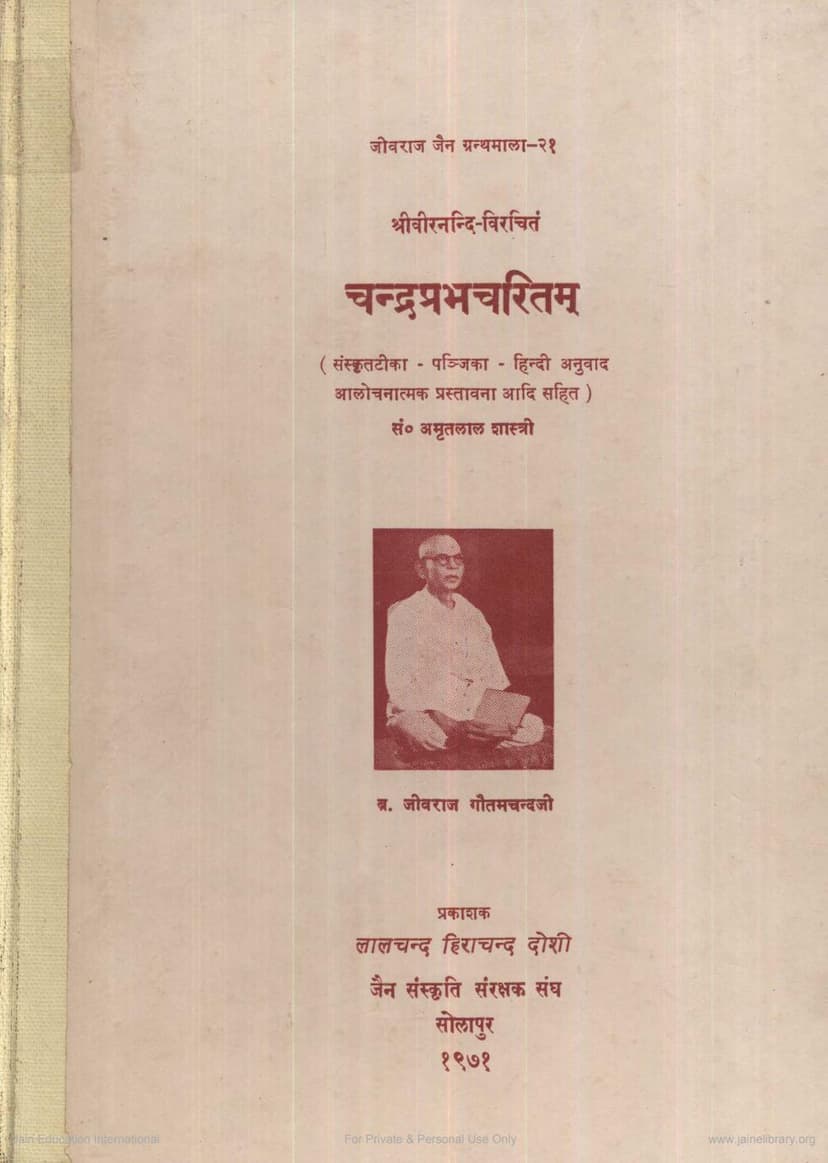Chandraprabhacharitam
Added to library: September 1, 2025

Summary
Based on the provided Jain text, here's a comprehensive summary in English of the Chandraprabhacharitam by Virnandi, with the critical edition and commentary by Amritlal Shastri:
Book Title: Chandraprabhacharitam Author: Virnandi Editor/Commentator: Amritlal Shastri Publisher: Lalchand Hirachand Doshi Jain Sanskriti Samrakshaka Sangha, Solapur Year of Publication: 1971 (Samvat 2028 Vikrami)
This book is the twenty-first publication in the Jivraj Jain Granthamala series, dedicated to preserving and promoting Jain culture and literature.
Overview:
The Chandraprabhacharitam is a Mahakavya (epic poem) composed by the renowned Jain monk Virnandi in the 11th century CE. It narrates the life story of the eighth Tirthankara, Chandraprabha. The work is highly regarded for its literary merit, incorporating the poetic conventions of its era, including elaborate descriptions, aesthetic principles (rasa), and figures of speech (alankara). Beyond its narrative and aesthetic qualities, the text also engages in philosophical and theological discussions, critiquing other religious and philosophical systems prevalent in ancient India, such as those of the Charvakas, Sankhyas, Jains, Buddhists, and Mimamsakas.
Key Features of the Edition:
This critical edition, meticulously prepared by Pt. Amritlal Shastri, is notable for its comprehensiveness:
- Critical Text: It is based on a critical collation of twelve ancient manuscripts of the original Sanskrit text, alongside the Sanskrit commentaries Vidvanmanovallabha by Municandra and Panjika by Gunanandi.
- Commentaries: The edition includes the Sanskrit commentary Vidvanmanovallabha by Municandra (composed in VS 1560) and the Panjika by Gunanandi (composed in VS 1597), making the original text accessible to scholars.
- Hindi Translation: A faithful Hindi translation of the original work accompanies the text, aiding understanding.
- Introduction and Appendices: Pt. Shastri provides an extensive critical introduction discussing the sources, the author, the commentary, and the literary aspects of the Chandraprabhacharitam. The appendices include indexes of verses, quotations from other texts within the commentaries, important words, and meter used.
- Scholarly Value: The edition is praised for its accuracy in text restoration and its thoroughness in providing scholarly apparatus, making it a valuable resource for understanding Jain literature, philosophy, and history.
Content and Themes:
- Life of Tirthankara Chandraprabha: The poem details the life of Tirthankara Chandraprabha, focusing on his transmigration through seven births before his birth as a Tirthankara.
- Past Lives: The first fifteen cantos (sargas) are dedicated to describing these six previous lives, illustrating the Jain principles of karma, reincarnation, and the path to liberation.
- Current Life (Tirthankara): The final three cantos focus on his birth as Chandraprabha, his renunciation, his attainment of omniscience (Kevala Jnana), his teachings, and his final liberation (Nirvana).
- Literary Excellence: The Chandraprabhacharitam is a significant work of Sanskrit literature. It is characterized by:
- Poetic Style: Elegant and refined language, rich descriptions of nature, cities, events, and human emotions.
- Rasa and Alankara: The poem masterfully employs various aesthetic sentiments (rasas) and figures of speech (alankaras), contributing to its artistic appeal.
- Vivid Imagery: The descriptions are often praised for their imaginative quality and ability to create vivid mental pictures for the reader.
- Philosophical and Theological Content:
- Jain Principles: The narrative is interwoven with core Jain doctrines such as the law of karma, the nature of the soul (jiva), the concept of liberation (moksha), and the importance of ethical conduct and asceticism.
- Critique of Other Philosophies: The second canto notably includes a detailed critique of various non-Jain philosophical schools, including the Charvakas, Sankhyas, Nyaya-Vaisheshikas, Buddhists, and Mimamsakas. This section highlights Virnandi's profound knowledge of comparative philosophy.
- Author's Legacy: Virnandi holds a significant place in Jain tradition. His work is cited by later prominent scholars like Nemichandra Siddhanta Chakravarti (who referred to Virnandi as his 'Vatsa' - son) and Vadiraja Suri, indicating his influence and popularity. The existence of commentaries and multiple manuscript copies attests to the widespread appreciation of his work.
In essence, the Chandraprabhacharitam, as presented in this edition, is a monumental work that serves as a testament to Virnandi's literary genius and his deep understanding of Jain philosophy and theology. The edition by Amritlal Shastri is invaluable for its scholarly rigor and its contribution to making this classic accessible to a wider audience.